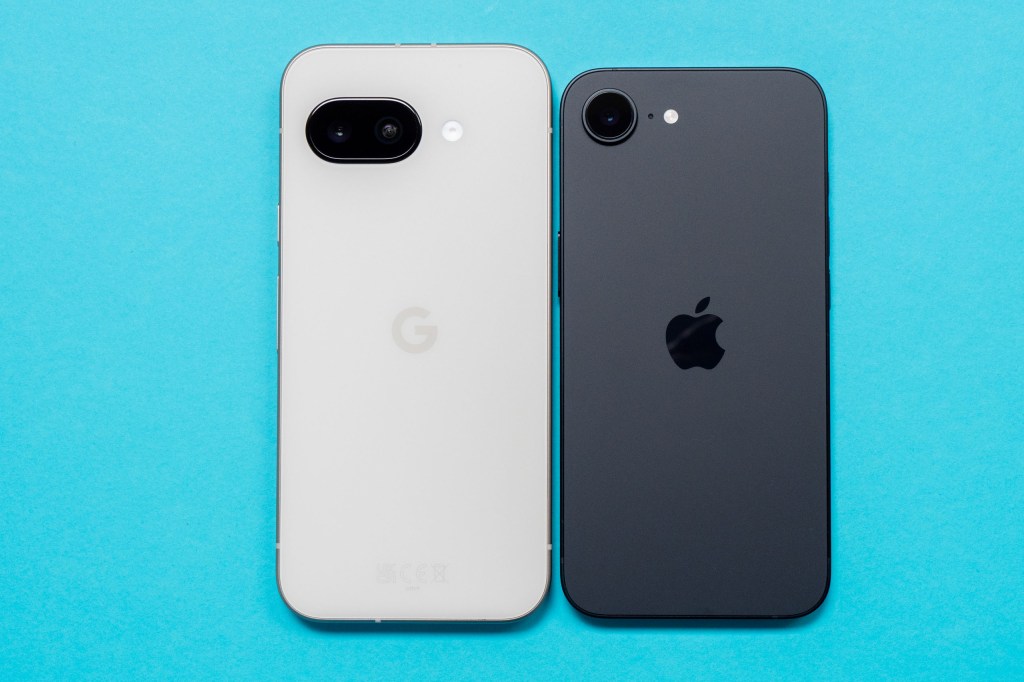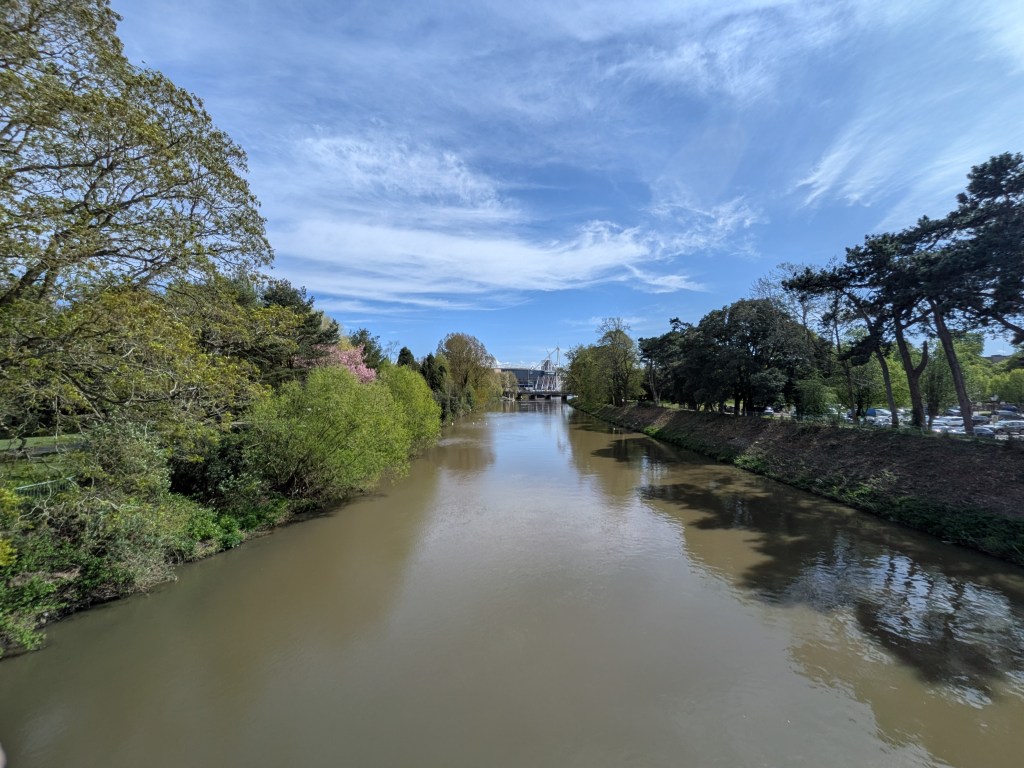If you’re in the market for one of the best budget smartphones, then there’s good news – there’s absolutely loads available at the moment.
For those who are Apple fans, the latest iPhone 16e is a “budget” offering (by Apple standards), which goes up squarely against other mid-range options, including the Google Pixel 9a.

To that end, I wanted to put both of these phones up against each other to see which would come out top. Do you actually need more than one lens, or will one do? Let’s find out…
iPhone 16e vs Google Pixel 9a: Specs
Take a look at the table below. I’ve compared some of the main specs of both the iPhone 16e and the Google Pixel 9a. I’ve concentrated on the features which are most likely to be useful or interesting to photographers.
Probably the biggest difference between the two models is that the iPhone 16e has just one lens, while the Pixel 9a has two. The two main lenses are quite similar, but with the 9a you get an ultrawide lens to go with it.

Both models offer in-sensor cropping, as well as digital zoom. Both have a 48MP main camera, but the iPhone’s output is 24MP, compared to 12MP for the Pixel 9a. The 9a has a slightly wider equivalent lens however, which is probably slightly more appealing to most people – but it’s not a hugely obvious difference.
| iPhone 16e | Google Pixel 9a |
|---|---|
| 48MP f/1.6 main (only camera), OIS, 24MP output, 26mm equivalent, 2x in-sensor crop zoom | 48MP f/1.7 main camera, OIS, 12MP output, 24mm equivalent, Super Res Zoom up to 8x |
| N/A | 13MP f/2.2 ultrawide camera |
| 12MP f/1.9 selfie camera | 13MP f/2.2 selfie camera |
| 4K 60fps video | 4K 60fps video |
| 6.1-inch OLED Super Retina 2532×1170 pixels, 1200 nits max brightness, Ceramic Shield Front | 6.3-inch Actua 2424x 1080 pixels, 2700 nits max brightness, Gorilla Glass 3 |
| IP68 splash, water and dust resistant | IP68 splash, water and dust resistant |
| Apple Intelligence, A18 Processor | Google Gemini, Tensor G4 processor |
| 26 hour battery life, wireless and fast charging (20W) available | 30+ hour battery life, 5100 mAh battery,wireless and fast charging (23W) available |
| 128/256/512GB | 128/256GB storage |
| 146.7 x 71.5 x 7.80mm, 167g | 154.7 x 73.3 x 8.9mm, 185.9g |
Elsewhere, other differences include the design. The Pixel 9a’s screen size is bigger, and it’s also brighter. Both are fairly resistant to modern life, with either a Gorilla Glass or Ceramic Shield screen, and both having IP68 water and dust proofing.

The native camera apps of both models are relatively straightforward, with both offering fewer options than we see in either option’s more expensive stablemates. For example, there’s no Pro offering with either model, nor the option to shoot in raw format either way. That said, the Pixel does have some more “fun” options, including the “Add Me” feature for taking couple or group shots without the need for an additional person.
Both models offer inbuilt AI functionality, which you can use for photography purposes to clean up scenes – such as removing stray tourists from your pictures.
iPhone 16e vs Google Pixel 9a: Image Quality
I used both of these phones in the same situations in order to directly compare the two. I’ve tried to cover off a range of shooting scenarios that most ordinary users are likely to be engaged with. Use the sliders to compare the results – the iPhone is always on the left, the Pixel always on the right.


Pictures from both the 1x lenses are very good. In some respects, they’re fairly similar, with both showing a good amount of detail and a similar focal length. However, the iPhone is much warmer than the Pixel 9a, which leads to more unnatural results. The likelihood is that if you saw the iPhone result on its own, you wouldn’t notice so much, but the disparity is quite obvious here. By contrast, the Pixel 9a’s looks more realistic, while staying vibrant.

There isn’t an ultrawide lens for the 16e, so obviously I can’t show you that. The Pixel 9a’s ultrawide lens isn’t as good as the 1x lens, but of course it’s better than no lens at all. It’s more than acceptable for sharing images on social media and so on.


Neither of the phones have a telephoto lens, but in-sensor cropping is possible thanks to high resolution 1x sensors. Here the 2x “zoom” option shows a fairly decent result from either option. I’d be more than happy to use these images on social sites etc. Again, the iPhone is too warmly coloured for my liking.


You can zoom up to 8x with the Pixel 9a, or 10x with the iPhone 16e. Fair to say however that neither result is particularly amazing – the Pixel’s is perhaps slightly better.


With no ultrawide lens for the iPhone 16e, that also means there’s no macro mode. Bringing AF to the ultrawide for the 9a (something the Pixel 8a didn’t have) means that macro focusing is now a possibility. That said, you still can’t get particularly close with it – indeed, the iPhone’s regular focusing option gets you about as close anyway, so the difference isn’t as big as you might expect it to be.


I’d put both of these images about on par with each other. There’s a similar amount of detail retained in both, with perhaps ever so slightly more from the Pixel in the foreground. Both show fairly obvious smudging in the trees. You can’t shoot ultrawide with the iPhone 16e, however, the low light results from the Pixel 9a’s ultrawide lens are really nothing to write home about, so that’s no huge loss anyway. If you want to shoot beyond 1x, again you’ll be relying on in-sensor cropping. Here, both produce fairly similar results again, both being just about OK for social media but not much more besides.


It’s possible to get pleasing portrait results from either the Google or the iPhone, so I’d probably put these fairly close together. The big problem for me however is that the iPhone can only recognise humans for portrait subjects, while the Pixel has no such restriction. Therefore if you like to photograph your dog, cat, or even an inanimate object, you can do that in Portrait mode with the Pixel – so I have to award that the rosette.


Both the selfie cameras here are 12MP, and both don’t have autofocus. They both do a decent enough job, but the Pixel’s is probably showing slightly nicer colours.
iPhone 16e vs Google Pixel 9a: Value for Money
I’ve said it before, and I’ll say it again, but it’s next to impossible to consider the iPhone 16e as offering anything like good value for money. Yes, it’s cheaper than flagship iPhones, but that doesn’t necessarily mean it’s a good purchase. And that’s before you start comparing it against its better-priced Android rivals, such as the 9a.
The iPhone has a starting price of $599/£599. That’s about $100/£100 more than the Pixel 9a – for which you’ll get an extra lens, a bigger and brighter screen and also a more attractive design (that last point is a personal preference). You could spend the same amount on the Pixel 9a and get 256GB of storage, too.

On top of that, I expect the Pixel 9a will drop in price a lot quicker than the iPhone 16e – so you may find that the price difference is even greater depending on when you’re reading this.
If you’re wedded to the idea of an Apple phone (I’m not sure why you’re reading this if so) then it may well be the only option for you. But for most, the Pixel 9a represents much better value.
iPhone 16e vs Google Pixel 9a: Verdict
If you’re keen to get a new phone but don’t want to spend a huge amount of money, both of these models are solid mid-range options.
However, I think it’s fair to say that the iPhone 16e is overpriced for what you get. While the Pixel 9a isn’t super cheap – there are even cheaper options available – you do get double the lenses, a better screen and actually in most cases, the photos are better too.

Of course, if you’re keen to stay within Apple’s ecosystem, then that’s absolutely fine, but for those who aren’t so fussed on that kind of thing, the Pixel 9a is the obvious choice.
If you’re happy to consider Android models, also take a look at the Oppo Reno 13 Pro, plus the Samsung Galaxy A56.





